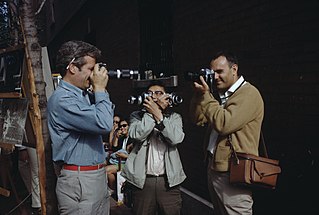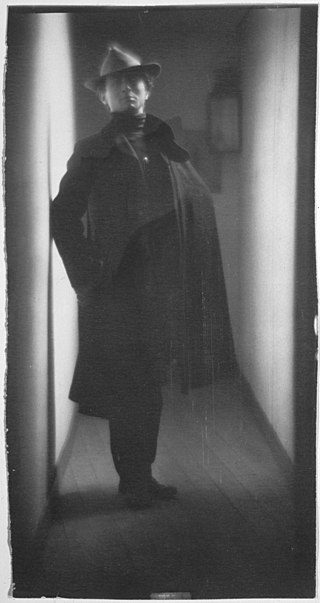Related Research Articles

Photography is the art, application, and practice of creating images by recording light, either electronically by means of an image sensor, or chemically by means of a light-sensitive material such as photographic film. It is employed in many fields of science, manufacturing, and business, as well as its more direct uses for art, film and video production, recreational purposes, hobby, and mass communication.

Stanley Kubrick was an American film director, producer, screenwriter and photographer. Widely considered one of the greatest filmmakers of all time, his films—nearly all of which are adaptations of novels or short stories—span a number of genres and are known for their intense attention to detail, innovative cinematography, extensive set design and dark humor.

Edward Jean Steichen was a Luxembourgish American photographer, painter, and curator, renowned as one of the most prolific and influential figures in the history of photography.

Paul Strand was an American photographer and filmmaker who, along with fellow modernist photographers like Alfred Stieglitz and Edward Weston, helped establish photography as an art form in the 20th century. In 1936, he helped found the Photo League, a cooperative of photographers who banded together around a range of common social and creative causes. His diverse body of work, spanning six decades, covers numerous genres and subjects throughout the Americas, Europe, and Africa.

Carl Mydans was an American photographer who worked for the Farm Security Administration and Life magazine.

Elliott Erwitt is a French-born American advertising and documentary photographer known for his black and white candid photos of ironic and absurd situations within everyday settings. He has been a member of Magnum Photos since 1953.
George William Adam Rodger was a British photojournalist noted for his work in Africa and for photographing the mass deaths at Bergen-Belsen concentration camp at the end of the Second World War.

The Widelux is a fully mechanical swing-lens panoramic camera first developed in Japan in 1958, by Panon Camera Shoko. There are both 35mm and medium-format models. Instead of a shutter, the camera has a slit that exposes the film as the lens pivots on a horizontal arc. This pivot allows for some distortion effects not available with traditional cameras. The last Widelux model F8 ended production in 2000.

Michael Benson is an American author, artist, filmmaker, and exhibitions producer whose most recent work centers on the convergence of art and science. In the last fifteen years Benson has produced a series of large-scale exhibitions of digitally constructed planetary landscapes in major international museums. His most recent book, Space Odyssey, is a detailed nonfiction examination of the production of Stanley Kubrick's 2001: A Space Odyssey. The book's publication was timed to coicide with the 50th anniversary of the film's theatrical release. Benson has written for The New York Times, The Washington Post, The New Yorker, The Atlantic, and Rolling Stone. He is currently using scanning electron microscope technologies at the Canadian Museum of Nature in Ottawa to view and photograph natural objects for a book and exhibition project titled Nanocosmos. He is a Fellow of the New York Institute of the Humanities, a Weizmann Institute Advocate for Curiosity, and was recently a Visiting Scholar at the Center for Bits and Atoms at the MIT Media Lab.

Antoinette Frissell Bacon, known as Toni Frissell, was an American photographer, known for her fashion photography, World War II photographs, and portraits of famous Americans, Europeans, children, and women from all walks of life.

Spirit photography is a type of photography whose primary goal is to capture images of ghosts and other spiritual entities, especially in ghost hunting. It dates back to the late 19th century. The end of the American Civil War and the mid-19th Century Spiritualism movement contributed greatly to the popularity of spirit photography. Photographers such as William Mumler and William Hope ran thriving businesses taking photos of people with their supposed dead relatives. Both were shown to be frauds, but "true believers", such as Sir Arthur Conan Doyle, refused to accept the evidence as proof of a hoax.

Esther Bubley was an American photographer who specialized in expressive photos of ordinary people in everyday lives. She worked for several agencies of the American government and her work also featured in several news and photographic magazines.

Jan Brunon Bułhak (1876–1950) was an early 20th century photographer in Poland and present-day Belarus and Lithuania. A published theoretician and philosopher of photography, he was an exponent of pictorialism. He is best known for his landscapes and photographs of various places, especially the city of Vilnius. He was the founder of the Wilno Photoclub and Polish Photoclub, the predecessors of the modern Union of Polish Art Photographers (ZPAF), of which he was an honorary office-holder. He is also known as an ethnographer and folklorist.

Arthur (Usher) Fellig, known by his pseudonym Weegee, was a photographer and photojournalist, known for his stark black and white street photography in New York City.
Petrus Graf von Schaesberg was a German art historian, artist, editor, and teacher.
John Blakemore, is an English photographer who has worked in documentary, landscape, still life and hand made books. He taught the medium full time from 1970.
Photo psychology or photopsychology is a specialty within psychology dedicated to identifying and analyzing relationships between psychology and photography. Photopsychology traces several points of contact between photography and psychology.

A list of books and essays about Stanley Kubrick and his films.

Photography in Sudan refers to both historical as well as to contemporary photographs taken in the cultural history of today's Republic of the Sudan. This includes the former territory of present-day South Sudan, as well as what was once Anglo-Egyptian Sudan, and some of the oldest photographs from the 1860s, taken during the Turkish-Egyptian rule (Turkiyya). As in other countries, the growing importance of photography for mass media like newspapers, as well as for amateur photographers has led to a wider photographic documentation and use of photographs in Sudan during the 20th century and beyond. In the 21st century, photography in Sudan has undergone important changes, mainly due to digital photography and distribution through social media and the Internet.
Jonathan Green is an American writer, historian of photography, curator, teacher, museum administrator, photographer, filmmaker and the founding Project Director of the Wexner Center for the Arts. A recognized authority on the history of American photography, Green’s books Camera Work: A Critical Anthology (1973) and American Photography: A Critical History 1945–1980 (1984) are two notable commentaries and frequently referenced and republished accounts in the field of photography. At the same time Green’s acquisitions, exhibitions and publications consistently drew from the edges of established photographic practice rather than from its traditional center. He supported acquisitions by socially activist artists like Adrian Piper and graffiti artist Furtura 2000, and hosted exhibitions on Rape, AIDS, new feminist art, and the work of photographer, choreographer and dancer Arnie Zane, the Diana camera images of Nancy Rexroth, the Polaroids and imitation biplanes of folk artist Leslie Payne, and the digital photographic work of Mexican photographer Pedro Meyer. This alternative focus help prime Green and the competition jury to choose an unconventional, deconstructive architect, Peter Eisenman, previously known primarily as a teacher and theorist, as the architect for the Wexner Center for the Arts. Green has held professorial and directorial positions at Massachusetts Institute of Technology, Ohio State University, and University of California, Riverside.
References
- ↑ Stanley Kubrick: Drama & Shadows: Photographs 1945-1950, Photo.com
- ↑ Stanley Kubrick, Photo.com
- ↑ Rainer Crone Stanley Kubrick Drama & Shadows: Photographs 1945-1950, Aperture Archive, Fall 2006
- ↑ 'Dr Strangelove, c'est moi', The Guardian, 26 November 2005
- ↑ Kubrick, in action, Los Angeles Times, 18 December 2005